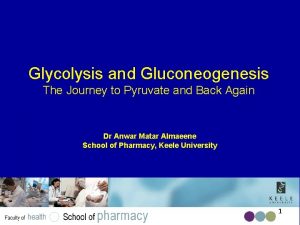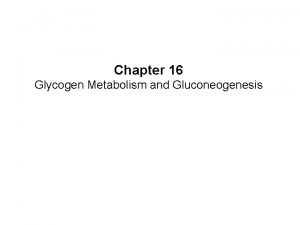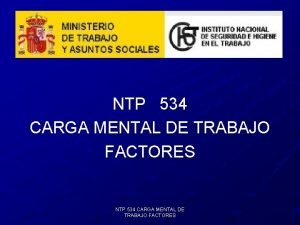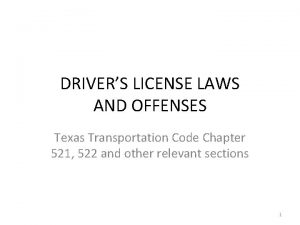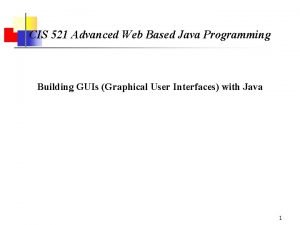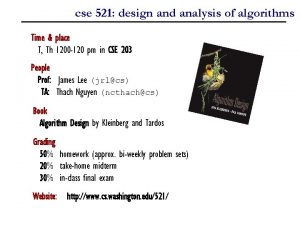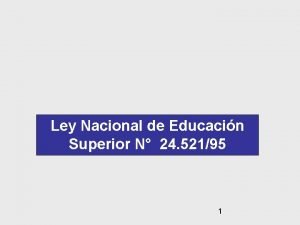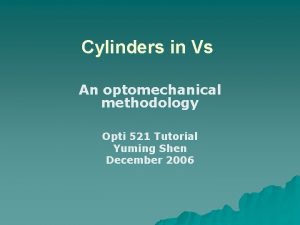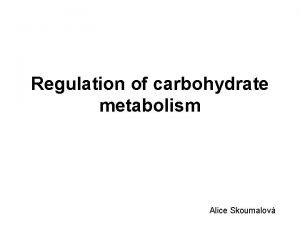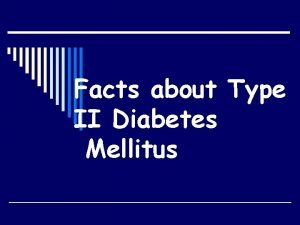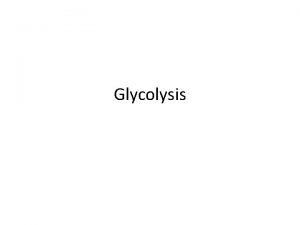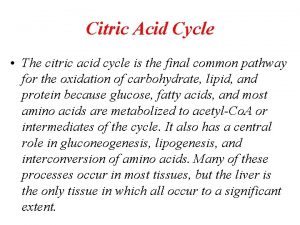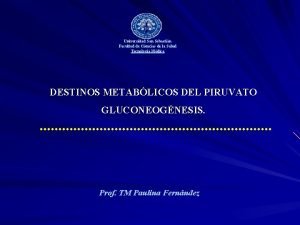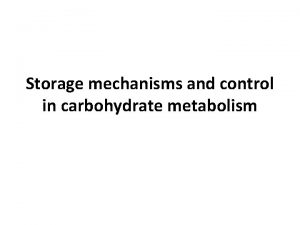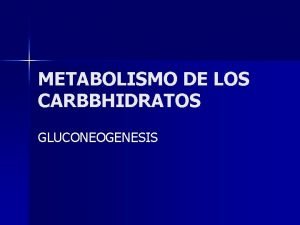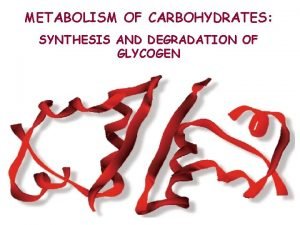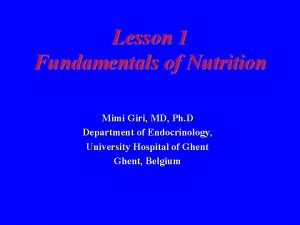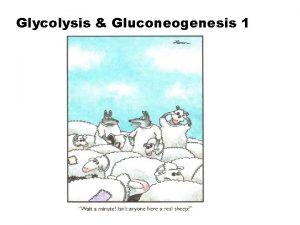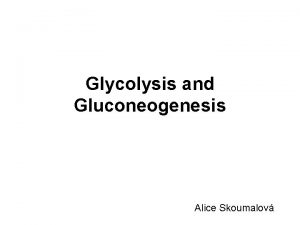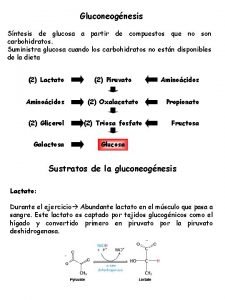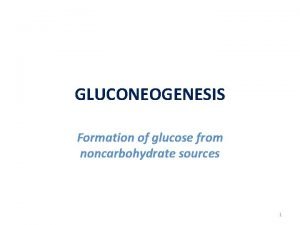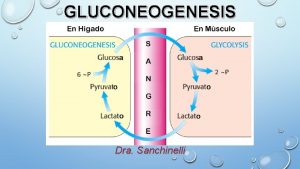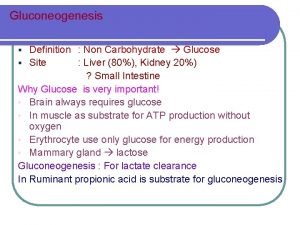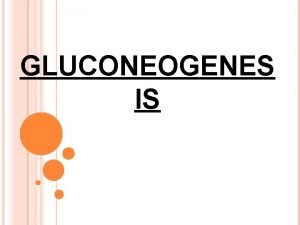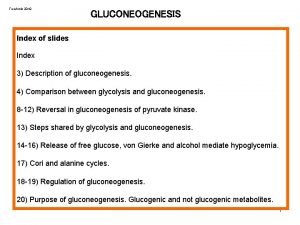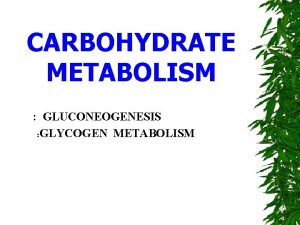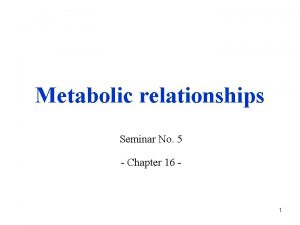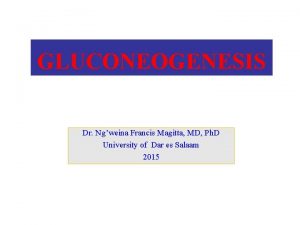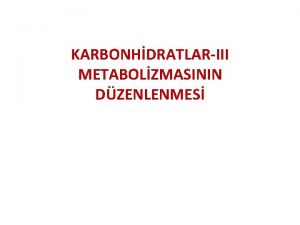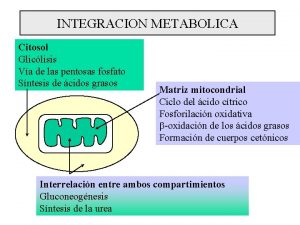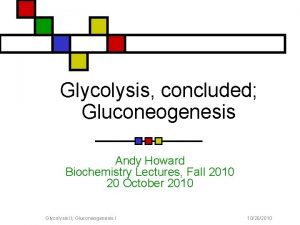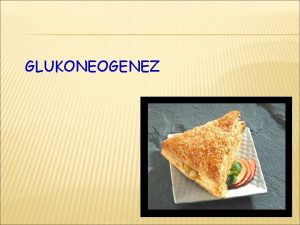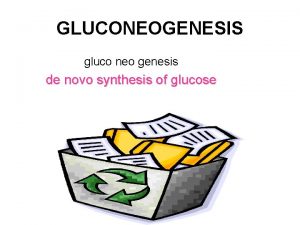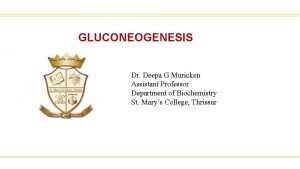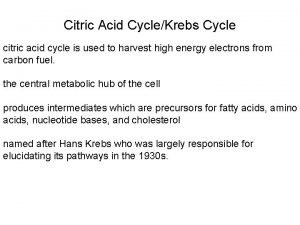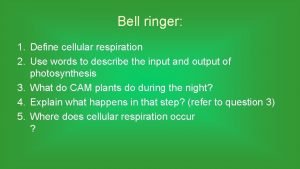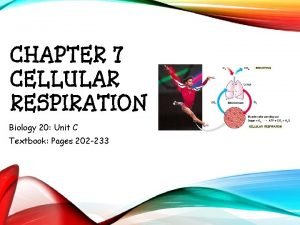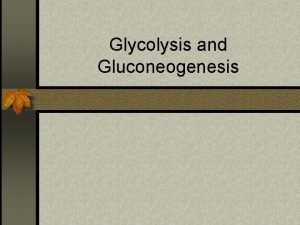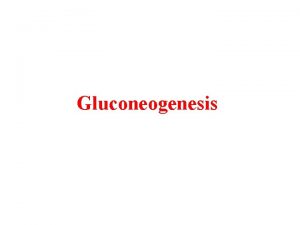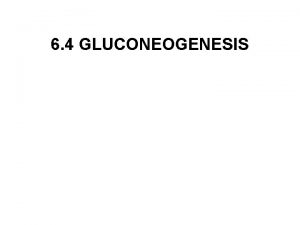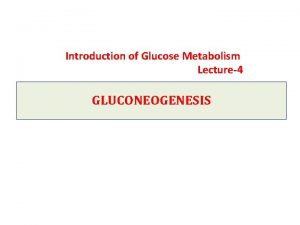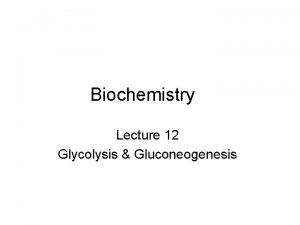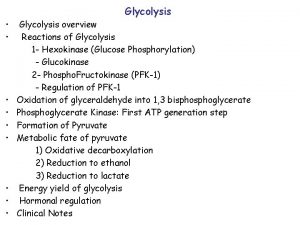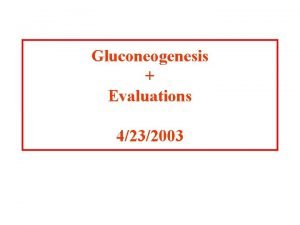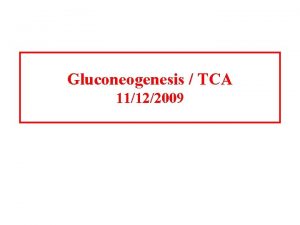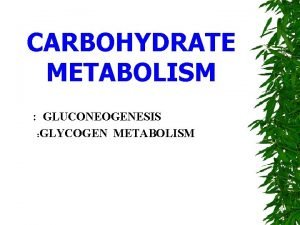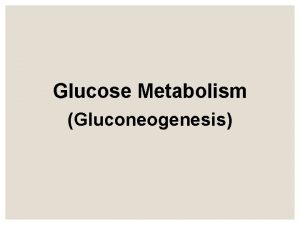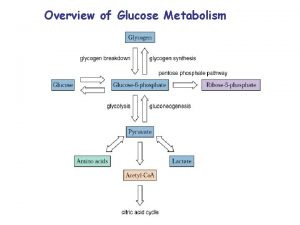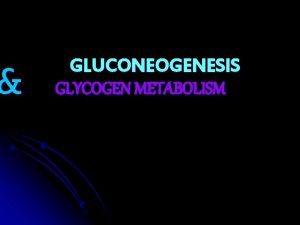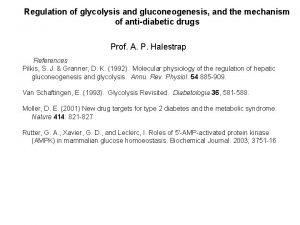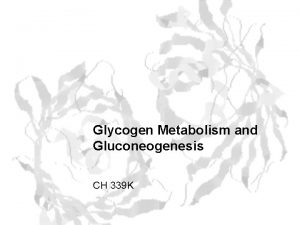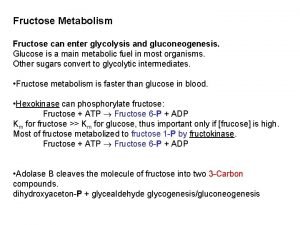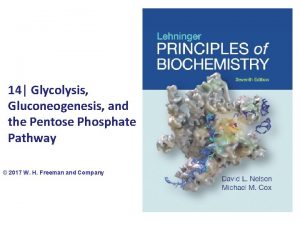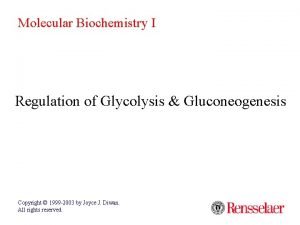Glycolysis and Gluconeogenesis Chapter 14 Page 521 534








































- Slides: 40

Glycolysis and Gluconeogenesis Chapter 14 (Page 521 -534, 543 -550, 554) 1

1. Central Importance of Glucose • Glucose is an excellent fuel – Yields good amount of energy upon oxidation – Can be efficiently stored in the polymeric form – Many organisms and tissues can meet their energy needs on glucose only • Glucose is a versatile biochemical precursor – Bacteria can use glucose to build the carbon skeletons of: • All the amino acids • Membrane lipids • Nucleotides in DNA and RNA • Cofactors needed for the metabolism

2. Four Major Pathways of Glucose Utilization • Storage – Can be stored in the polymeric form (starch, glycogen) – When there’s plenty of excess energy • Synthesis of Structural Polysaccharides – For example, in cell walls of bacteria, fungi, and plants – Extracellular matrix • Glycolysis – Generates energy via oxidation of glucose – Short-term energy needs • Pentose Phosphate Pathway – Generates NADPH via oxidation of glucose – For detoxification and the biosynthesis of lipids and nucleotides

2. Four Major Pathways of Glucose Utilization

3. Overview of Glycolysis and Gluconeogenesis Glucose Glycolysis Gluconeogensis

Glycolysis 6

1. Glycolysis: Overview • In the evolution of life, glycolysis probably was one of the earliest energy-yielding pathways. • It developed before photosynthesis, when the atmosphere was still anaerobic. • Thus, the task upon early organisms was: How to extract free energy from glucose anaerobically? • The solution: – First: Activate it by phosphorylation – Second: Collect energy from the high-energy metabolites

1. Glycolysis: Overview • The chemistry of this reaction sequence has been completely conserved. – The glycolytic enzymes of vertebrates are closely similar in AA sequence and 3 -D structure to their homologs in yeast and spinach. • Glycolysis differs among species only in the details of its regulation and in the subsequent metabolic fate of the pyruvate formed.

1. Glycolysis: Overview We will be focusing on aerobic glycolysis, which involves: A. Cytosolic enzymes (soluble) B. Substrate-level phosphorylation § Involves soluble enzymes and chemical intermediates

2. Glycolysis: Importance • Sequence of enzyme-catalyzed reactions by which glucose is converted into pyruvate • Pyruvate can be further aerobically oxidized • Pyruvate can be used as a precursor in biosynthesis • Some of the free energy from oxidation is captured by the synthesis of ATP and NADH • Research of glycolysis played a large role in the development of modern biochemistry – Understanding the role of coenzymes – Discovery of the pivotal role of ATP – Development of methods for enzyme purification

3. Feeder Pathways for Glycolysis

3. Feeder Pathways for Glycolysis • Glucose molecules are cleaved from glycogen and starch by glycogen phosphorylase – Yielding glucose-1 -phosphate • Disaccharides are hydrolyzed – Lactose: glucose and galactose – Sucrose: glucose and fructose • Fructose, galactose, and mannose enter glycolysis at different points

4. Glycolysis: Overview

4 A. Glycolysis: The Preparatory Phase • Kinase: Enzyme that catalyzes the phosphorylation of certain molecules by ATP. • For each glucose, two molecules of glyceraldehyde-3 phosphate are formed. • Two ATP are consumed.

4 B. Glycolysis: The Payoff Phase • Dehydrogenase: Enzyme that catalyzes the removal of pairs of hydrogen atoms from their substrates. • NAD+ (Nicotinamide adenine dinucleotide)

4 B. Glycolysis: The Payoff Phase • Each phosphoryl (P) has two negative charges (PO 32 -). • Four ATP are formed. • Two molecules of pyruvate are produced.

Step 1: Phosphorylation of Glucose • The terminal phosphorus undergoes nucleophilic attack by the highlighted OH group of glucose. - ATP appears as Mg. ATP to shield the negative charge.

Step 1: Phosphorylation of Glucose • Rationale – Traps glucose inside the cell because there are no transporters that facilitate export of phosphorylated glucose out of the cell – Lowers intracellular glucose concentration to allow further uptake • This process uses the energy of ATP

Step 1: Phosphorylation of Glucose • Nucleophilic oxygen at C 6 of glucose attacks the last ( ) phosphate of ATP • ATP-bound Mg 2+ facilitates this process by shielding the negative charges on ATP • Highly thermodynamically favorable/irreversible – Regulated mainly by substrate inhibition

Step 2: Phosphohexose Isomerization

Step 2: Phosphohexose Isomerization • Rationale – C 1 of fructose is easier to phosphorylate by PFK – Allows for symmetrical cleave by aldolase • An aldose (glucose) can isomerize into a ketose (fructose) via an enediol intermediate • The isomerization is catalyzed by the active-site glutamate, via general acid/base catalysis • Slightly thermodynamically unfavorable/reversible – Product concentration kept low to drive forward ΔG = ΔG’° + RT ln [P]/[S]

Mechanism of Phosphohexose Isomerase

Step 3: 2 nd Priming Phosphorylation

Step 3: 2 nd Priming Phosphorylation • Rationale – Further activation of glucose – Allows for 1 phosphate/3 -carbon sugar after step 4 • First Committed Step of Glycolysis – Fructose 1, 6 -bisphosphate is committed to become pyruvate and yield energy • This process uses the energy of ATP • Highly thermodynamically favorable/irreversible

Step 4: Aldol Cleavage of F-1, 6 -b. P

Step 4: Aldol Cleavage of F-1, 6 -b. P • Rationale – Cleavage of a six-carbon sugar into two three-carbon sugars – High-energy phosphate sugars are three-carbon sugars • Animal and plant aldolases employ covalent catalysis • Thermodynamically unfavorable/reversible – GAP concentration kept low to pull reaction forward

Mechanism of Class I Aldolases: Covalent Catalysis

Mechanism of Class I Aldolases: Base Catalysis

Mechanism of Class I Aldolases: Base Catalysis

Mechanism of Class I Aldolases: Acid Catalysis

Mechanism of Class I Aldolases: Release of Product

Step 5: Triose Phosphate Interconversion

Glucose Carbons in GAP

Step 5: Triose Phosphate Interconversion • Rationale: – Allows glycolysis to proceed by one pathway – Completes preparatory phase • Aldolase creates two triose phosphates: – – Dihydroxyacetone Phosphate (DHAP) Glyceraldehyde-3 -Phosphate (GAP) Only GAP is the substrate for the next enzyme DHAP must be converted to GAP • Thermodynamically unfavorable/reversible – GAP concentration kept low to pull reaction forward

Step 6: Oxidation of GAP

Step 6: Oxidation of GAP +1 NAD+ + H+ + 2 e- → NADH +3

Step 6: Oxidation of GAP • Rationale: – Generation of a high-energy phosphate compound – Incorporates inorganic phosphate – Which allows for net production of ATP • Oxidation of aldehyde with NAD+ gives NADH • Active site cysteine – Forms high-energy thioester intermediate – Subject to inactivation by oxidative stress • Thermodynamically unfavorable/reversible – Coupled to next reaction to pull forward

Mechanism of GAPDH

Step 7: 1 st Production of ATP

Step 7: 1 st Production of ATP • Rationale: – Substrate-level phosphorylation to make ATP • 1, 3 -bisphoglycerate is a high-energy compound – Can donate the phosphate group to ADP to make ATP • Kinases are enzymes that transfer phosphate groups from ATP to various substrates • Highly thermodynamically favorable/reversible – Is reversible because of coupling to GAPDH reaction
 Regulation of glycolysis and gluconeogenesis
Regulation of glycolysis and gluconeogenesis Glucogen metabolism
Glucogen metabolism Ntp 534
Ntp 534 Texas transportation code 521
Texas transportation code 521 Cis 521
Cis 521 Cse 521
Cse 521 Zemax thermal analysis
Zemax thermal analysis Ley 24 521
Ley 24 521 Optisystem tutorial
Optisystem tutorial Glycolysis
Glycolysis Glycogenolysis and gluconeogenesis
Glycogenolysis and gluconeogenesis Amp glycolysis
Amp glycolysis Krebes cycle
Krebes cycle Apa cover pafe
Apa cover pafe Precursores de gluconeogenesis
Precursores de gluconeogenesis Glucogenesis vs gluconeogenesis
Glucogenesis vs gluconeogenesis Gluconeogenesis sustrato y producto
Gluconeogenesis sustrato y producto Glycogen metabolism
Glycogen metabolism Gluconeogenesis purpose
Gluconeogenesis purpose Hexokinase phosphofructokinase and pyruvate kinase
Hexokinase phosphofructokinase and pyruvate kinase Precursor of gluconeogenesis
Precursor of gluconeogenesis Gluconeognesis
Gluconeognesis Pep carboxykinase
Pep carboxykinase Precursores de gluconeogenesis
Precursores de gluconeogenesis Gluconeogenesis definition
Gluconeogenesis definition What are the substrates for gluconeogenesis
What are the substrates for gluconeogenesis Glycolysis overall reaction
Glycolysis overall reaction Net reaction of gluconeogenesis
Net reaction of gluconeogenesis Gluconeogenesis from lactate
Gluconeogenesis from lactate Gluconeogenesis from lactate
Gluconeogenesis from lactate Glukoneogenez
Glukoneogenez Piruvato
Piruvato Glucose 6 phosphatase
Glucose 6 phosphatase Pirüvat karboksilaz koenzimi
Pirüvat karboksilaz koenzimi Glucose neogenesis
Glucose neogenesis Pyruvate carboxylase gluconeogenesis
Pyruvate carboxylase gluconeogenesis Insulin and glycolysis
Insulin and glycolysis Insulin and glycolysis
Insulin and glycolysis Krebs cycle inputs
Krebs cycle inputs Input of krebs cycle
Input of krebs cycle Nelson biology 20 answer key
Nelson biology 20 answer key
